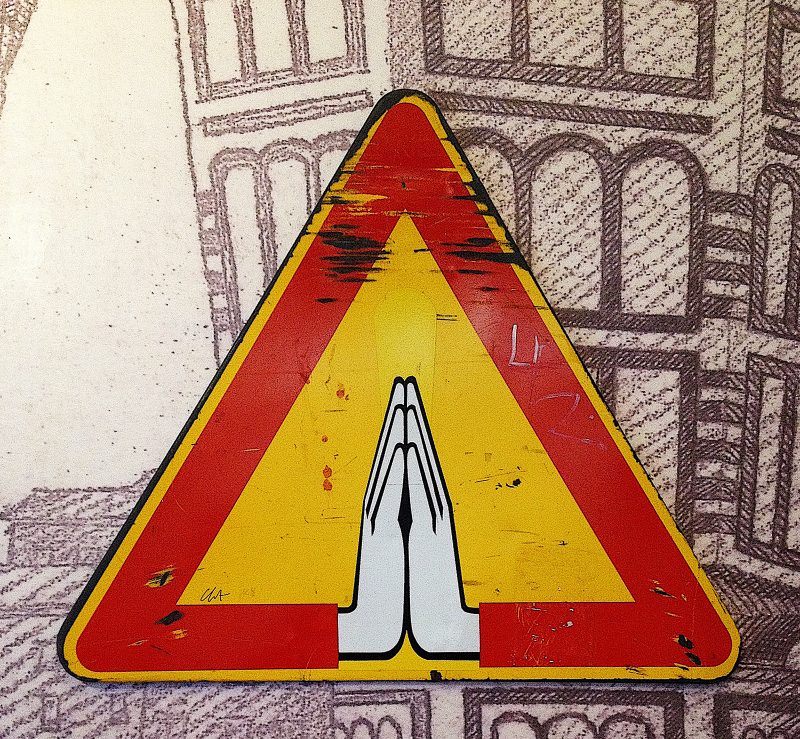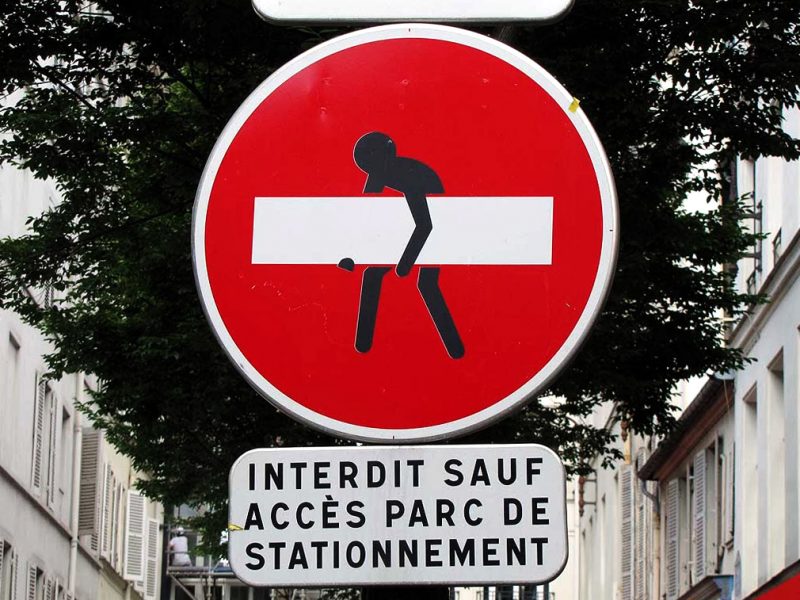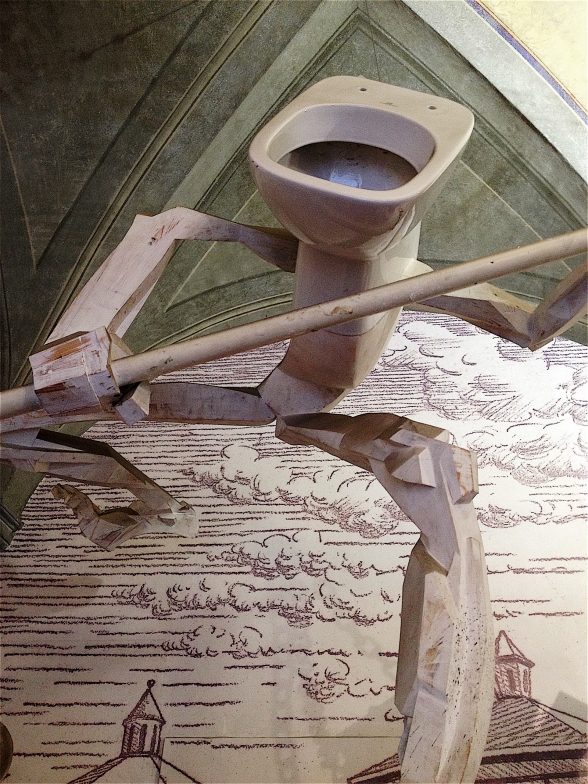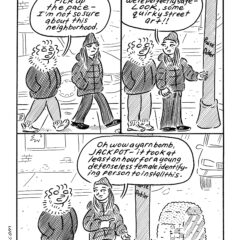French artist Clet Abraham, aka “Clet,” (pronounced “Klet” hard “t” at the end) has a thing for traffic signs. He likes a nice white arrow on a blue circular ground, or sharp red on a yellow triangle, but mostly he’s smitten with the white bar on a red circle – a symbol drivers the world over take for Do Not Enter.
Clet (born 1966) typically scrambles up city street poles and slaps on his carefully-made graphics (on stickers), effectively altering the visuals. A yield sign instantly becomes a pair of hands in prayer; a No Exit “T” morphs into Jesus on a crucifix; a Do Not Enter panel, with its white bar and red ground, serves as a pool for a drowning man a man locked in a pillory or thief attempting to make off with the white bar.

Florence-based artist makes city his semiotics lab
The artist who has lived and worked in Florence for some 20 years produces an art characterized by ironic additions and alterations to existing images; his work on the street is an ongoing semiotic laboratory, and there’s a long history of playful work with signs and symbols in the history of art, begun a century ago when Duchamp scribbled a mustache on a store-bought postcard of the Mona Lisa.
Working with street signs offers Clet a small canvas and the ability to spread his images like viruses across cities; street signs – even those altered by Clet – don’t seem to be at great risk of being stolen, erased or removed. The artist has a free hand to paste his poetic commentary on local politics, regulations and at times current events. For example, in Madrid where bullfights still exist, the artist added bull horns to the white bar of a Do Not Enter sign, endorsing, he said in various press reports, the liberation of bulls, and people.
Some more examples and trouble in Japan
Clet’s graphic vocabulary marries well with international street signs, and skips easily across cultures. Here’s Snoopy taking a nap on the white bar, or a spilled glass of wine, a rocker jamming with an arrow in lieu of a guitar, Pac Man chewing away at the white bar. Cleverly devised text covered the white bar in another work in Florence on the edge of the River Arno there, spelling out “LIBERI” (“FREE”). Clet’s also produced a Stop Sign work with the word “Art” strategically placed on it – a self-referential poke at his own semiotic habits.

His playful, graphic works have occasionally gotten him in trouble with the local law enforcement agencies. Though Clet respects the original function of the street signs, some authorities beg to differ and he’s occasionally arrested, fined, then let go. The Japanese for example were not happy about his “valentines” – white arrows piercing through pink hearts on Osaka streets. Clet’s Japanese girlfriend Mami was arrested by Osaka police in 2015 for allegedly helping him place some 80 works on various signs in Japan.
But Clet, undeterred, cycles on doing his work in cities across Europe.
An artist adopted by his public whose Florence art studio is a tourist attraction
Clet told Le Point Culture some years ago: ”As an artist who doesn’t have a gallery, the street gave me the possibility to have direct access to the public – and to be adopted by them.”
The artist maintains a visible active studio in Florence that is something of a tourist attraction. Across a tiny street from San Niccolò church, the studio is as busy as any leather goods store in town. Dozens of 20-somethings checked out the work space, buying postcards, stickers or musing over Clet’s giant toilet sculpture.

I spoke with one of Clet’s friends just outside the studio (the artist was away in Brittany, France) and asked him about whether collectors were pulling down street signs to grab a Clet art work, much like Banksy collectors chipped away the British artist’s spray painted works on walls in London.
“No they would never do that,” Clet’s friend said. “It’s public property, no? And it’s not so easy to steal – you have to climb up and unbolt it…it’s too hard.”
Sculptural figure of “Common Man” repeatedly bolted to Ponte alle Grazie by Clet and removed by city
Clet also produces cubist-like sculptural figures, like his white porcelain toilet man, and others cast in fiberglass. His “Uomo Comune” or “Common Man” was bolted illegally in 2011 to the Ponte alle Grazie (the one facing the celebrated Ponte Vecchio) not once but twice. The city of Florence fined the artist and removed it, but in 2013 Clet put it up again. And again, it was removed! Clet returned to the Ponte alle Grazie in 2016 and rebolted his “Common Man” in an almost inaccessible spot on the stanchion of the bridge. The figure is shown stepping into the void – the River Arno just below – frozen in time.
Commenting on this most recent guerrilla installation, Clet told The Florentine : “This time it’s made to last … Florence is opening up to contemporary art and it’s a positive thing – an alternative is needed to institutional art.”

Philadelphia has its own street sign maker, Kid Hazo
[Ed. Note] For a local take on street sign art, check out Philadelphia’s own Kid Hazo, who manufactures fake street signs that point out some of life’s absurdities.









